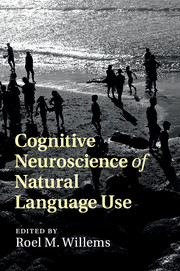Book contents
- Cognitive Neuroscience of Natural Language Use
- Cognitive Neuroscience of Natural Language Use
- Copyright page
- Contents
- Plates
- Figures
- Contributors
- Abbreviations
- 1 Cognitive neuroscience of natural language use: introduction
- 2 fMRI methods for studying the neurobiology of language under naturalistic conditions
- 3 Why study connected speech production?
- 4 Situation models in naturalistic comprehension
- 5 Language comprehension in rich non-linguistic contexts: combining eye-tracking and event-related brain potentials
- 6 The NOLB model: a model of the natural organization of language and the brain
- 7 Towards a neurocognitive poetics model of literary reading
- 8 Putting Broca’s region into context: fMRI evidence for a role in predictive language processing
- 9 Towards a multi-brain perspective on communication in dialogue
- 10 On the generation of shared symbols
- 11 What are naturalistic comprehension paradigms teaching us about language?
- Index
6 - The NOLB model: a model of the natural organization of language and the brain
Published online by Cambridge University Press: 05 February 2015
- Cognitive Neuroscience of Natural Language Use
- Cognitive Neuroscience of Natural Language Use
- Copyright page
- Contents
- Plates
- Figures
- Contributors
- Abbreviations
- 1 Cognitive neuroscience of natural language use: introduction
- 2 fMRI methods for studying the neurobiology of language under naturalistic conditions
- 3 Why study connected speech production?
- 4 Situation models in naturalistic comprehension
- 5 Language comprehension in rich non-linguistic contexts: combining eye-tracking and event-related brain potentials
- 6 The NOLB model: a model of the natural organization of language and the brain
- 7 Towards a neurocognitive poetics model of literary reading
- 8 Putting Broca’s region into context: fMRI evidence for a role in predictive language processing
- 9 Towards a multi-brain perspective on communication in dialogue
- 10 On the generation of shared symbols
- 11 What are naturalistic comprehension paradigms teaching us about language?
- Index
Summary
Existing models of the organization of language and the brain (OLB) can not explain natural language comprehension. They do not account for (i) the anatomical and functional data, (ii) how we overcome language ambiguity, (iii) how networks supporting language interact with each other or other networks, (iv) the computations performed in those networks or (v) language use, including how the brain uses the contextual information available in the real-world (e.g., co-speech gestures). A model of the natural OLB (NOLB) is presented that attempts to address these shortcomings. The NOLB model is dynamic, network oriented and organized around context and not necessarily linguistic levels or units of analysis. Specifically, it consists of many self-organizing, distributed, simultaneously active and synchronous context networks (cnets) that cooperate and compete. These cnets are weighted by the context that is available, prior experience with that context and by other cnets. Each cnet actively uses context to predict language input. The result is to constrain language ambiguity, speed up processing and free up metabolic resources. The NOLB model can serve as a framework to generate and test hypotheses, perhaps leading to needed progress in our understanding of natural language use and the brain.
- Type
- Chapter
- Information
- Cognitive Neuroscience of Natural Language Use , pp. 101 - 134Publisher: Cambridge University PressPrint publication year: 2015
- 20
- Cited by

